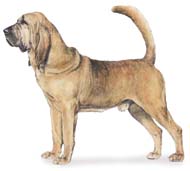INSTANT PROMOTION - LIMITED TIME OFFER - GET YOUR PUPPY COUPON TODAY
Hicksville: 516-938-7877
Lynbrook: 516-825-7877
Hicksville: 516-938-7877
Lynbrook: 516-825-7877
Currently we do not have any Bloodhound Puppies available.
Please complete the form below to be notified when they are back in our stores.

Other Names: St. Hubert’s Hound, Chien de Saint Hubert
Type: Scenthound
Height: Females: 23 – 25 inches; Males: 25 – 27 inches. Weight: Males: 90 – 110 lbs.; Females: 80 – 100 lbs.
Colors: Black and tan, liver (red) and tan, or red, often having small patches of white on the chest, feet and tip of tail. Coat: Smooth, short, thick and hard. It is also weatherproof.
Temperament: Bloodhounds are determined, responsive, gentle, affectionate, and sensitive. They are good with almost anyone they come in contact with and will be friendly with them. They can be stubborn when on a trail and will not be called off. They can be difficult to train and when outside become rather independent. Inside they remain calm, quiet and affectionate. They are reserved with strangers. With Children: Yes, Bloodhounds are good with children. With Pets: Yes, they are good with other pets and dogs. Friendly towards almost anyone. Special Skills: Bloodhounds are scent hounds and have the best tracking nose of any breed.
Watch-dog: High. Bloodhounds will bay at an interesting scent they might find. Guard-dog: Low. They are used to track down lost hikers and children because they do not attack the source of the scent, and are friendly towards most creatures.
Care and Training: Bloodhounds’ short coats requires a rub down with a wet towel several times a week. They can also be groomed with a hound glove. Toenails need weekly clipping. Care should be taken to keep their ears clean, as they are floppy and hang low to the ground. The Bloodhound requires daily exercise, long walks being the best. They have dewlaps and flaps of skin hanging all over which should be cleaned. Special Needs: Attention, ear cleaning, exercise, fenced yard and a leash. Learning Rate: Medium – Low. Because Bloodhounds are stubborn they seem difficult to train and do not like obeying their master’s every whim.
Activity: Indoors: Low. Indoors Bloodhounds are usually calm and quiet and relaxed. Outdoors: High. Outdoors, Bloodhounds can be very active due to the scents they might find around the house. They do require a lot of space since they are large dogs. Living Environment: The edge of a national forest with no neighbors within earshot. Loves the hunt, needs a big family and other bloodhounds. Bloodhounds love to bay and therefore should be in an area that is not largely affected by loud sounds. They also need a rather large yard and room to run. Bloodhounds will not be moved by their master when on a scent, and therefore need an enclosed yard with a fence. They should also be kept on a leash when outside of a yard or house due to their disobedience. Bloodhounds do best in rural homes with a patient owner.
Health Issues: Inverted eyelids, ear infections, hip and elbow dysplasia, and bloat. Bloat is a health issue to most dogs, being the second largest killer of dogs other than cancer, but Bloodhounds can be particularly susceptible to it because of their deep chests. Other health concerns include: cardiac problems, luxating patellas, thyroid disorders, gastric torsion (twisted stomach), skin-fold dermatitis.
Life Span: 7 – 11 years. Litter Size: 7 – 8 puppies.
Country of Origin: Belgium History: The Bloodhound is one of the oldest hound breeds, originating from ancestors who were bred in Assyria around 2000 – 1000 B.C. It is thought that these dogs were taken to the Mediterranean by the Phoenicians, and then from there spread north into Europe. Their ancestry, thought to be the St. Hubert hound can be traced to the seventh and eighth centuries in Belgium. Bloodhounds were brought to Great Britain by William the Conqueror in 1066. The Bloodhound is said to be the result of pure breeding thanks to monasteries and church dignitaries. Their name comes from the English blue bloods who helped nurture the breed, as well as their untainted blood. The original Bloodhounds were black or white; the whites being named Southern hounds, and the blacks being named Saint Hubert hounds. The Bloodhound was introduced to America in the mid 1800s, and has since proven itself as a useful companion dog. Bloodhounds at one time were the only dog accepted as an evidence-finding dog in the U.S. court of law. They have since found hundreds if not thousands of criminals, lost children, hikers and others. The Bloodhound has an olfactory system the size of a handkerchief and can smell over 40 times better than that of a human being. It is estimated they have at least 250 million olfactory receptors, and can smell out a trail over 2 weeks old. In the past these dogs were used for hunting by the church dignitaries, and are still used for that purpose by common people today. Bloodhounds these days are widely used as family pets, tracking dogs, and police dogs.
First Registered by the AKC: 1885 AKC Group: Hound Class: Hound Registries: AKC, ANKC, CKC, FCI (Group 6), KC (GB), UKC